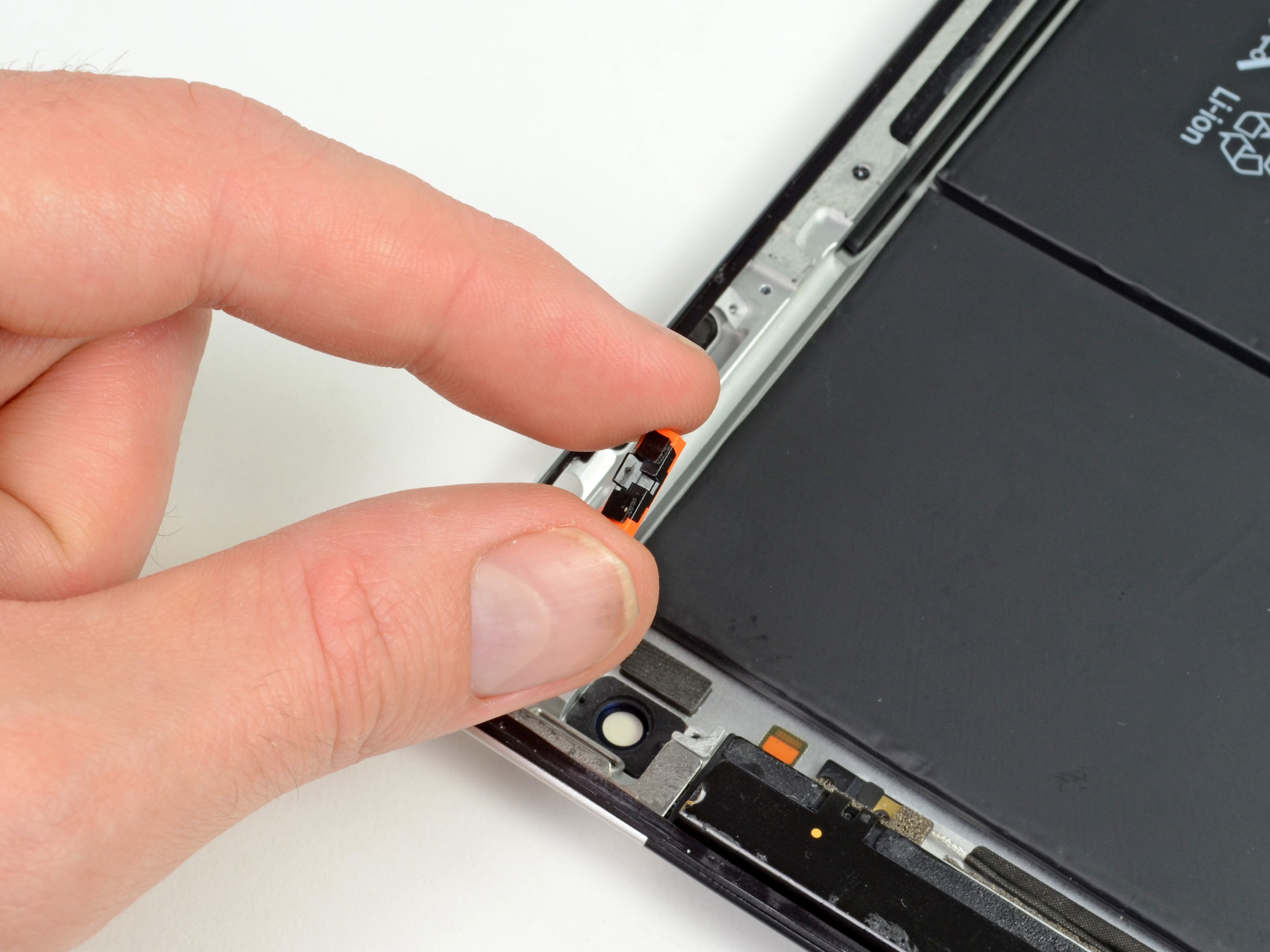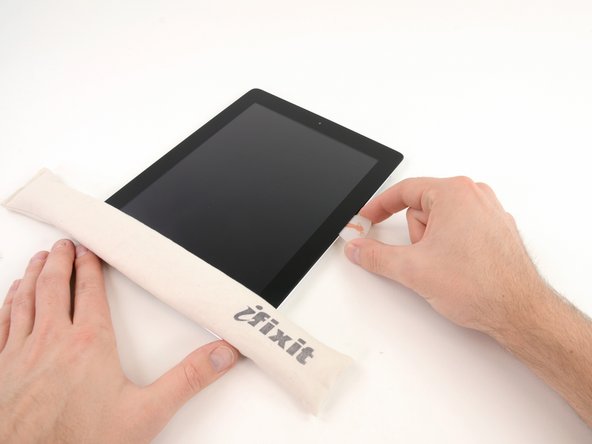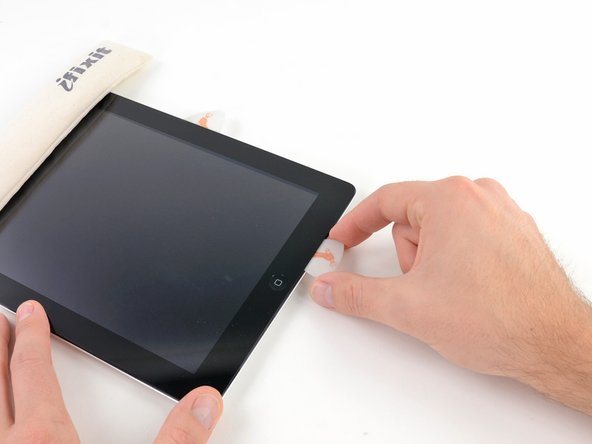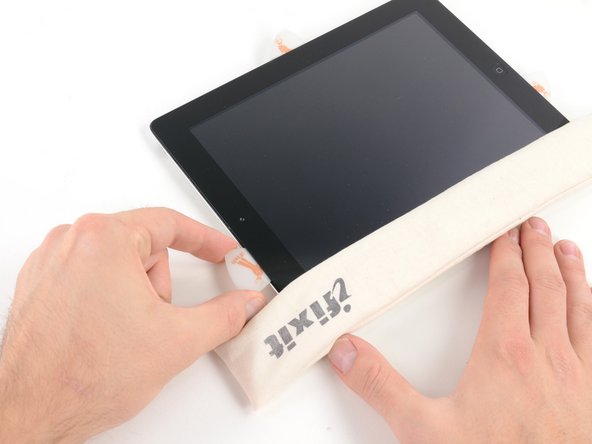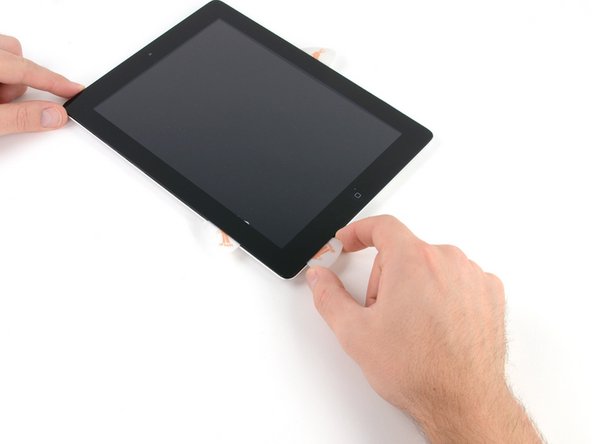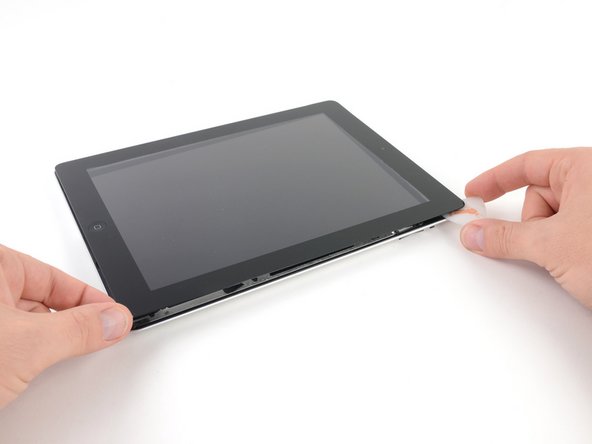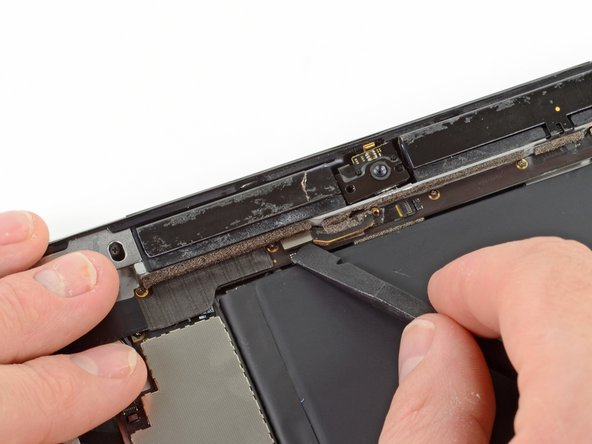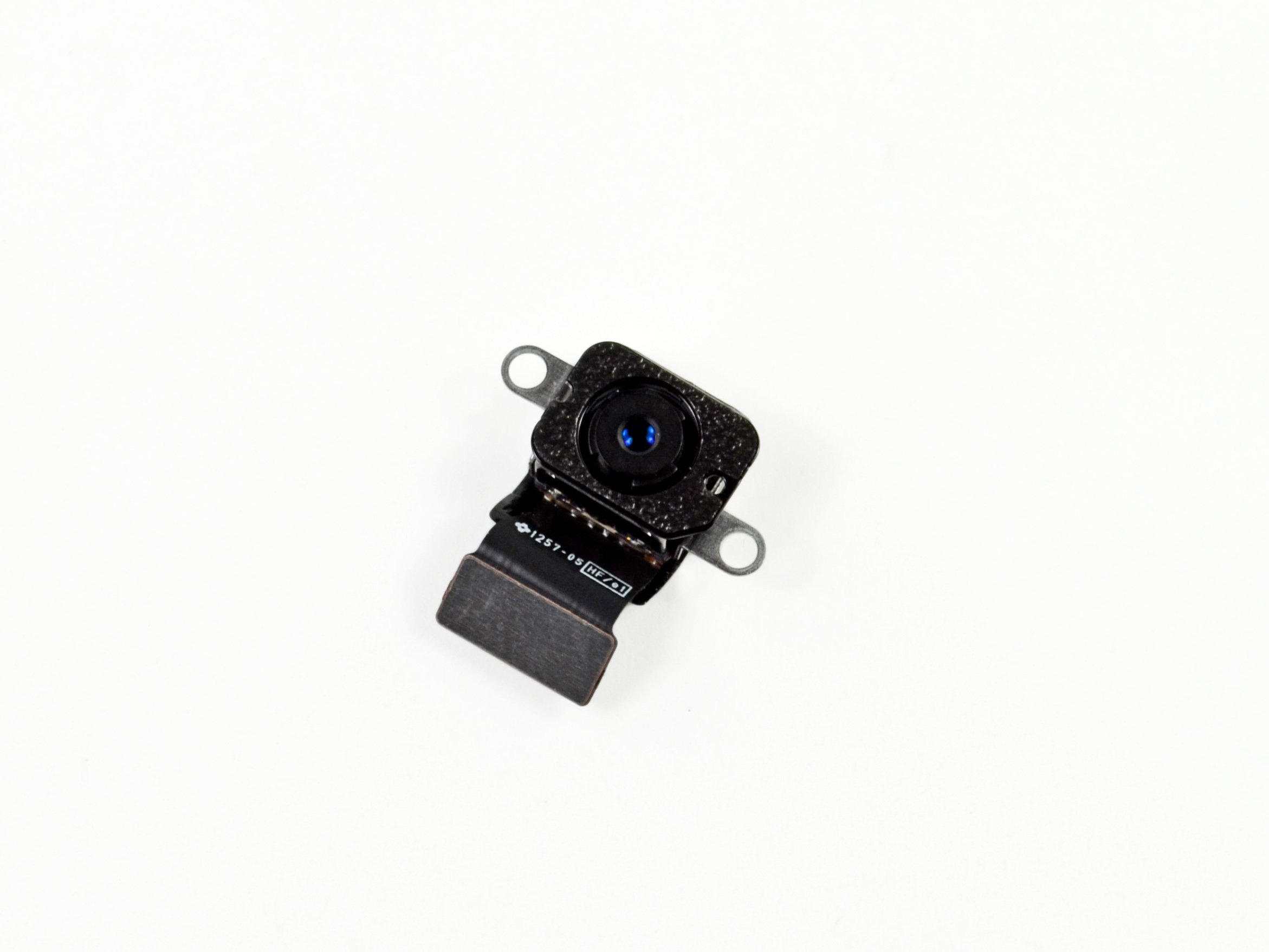iPad 4 CDMA Rotation Lock/Mute Switch Replacement
Duration: 45 minutes
Steps: 67 Steps
Ready to swap out that rotation lock/mute switch? No problem, we’ve got you covered! Just follow these simple steps, and you'll have it back in action in no time. If things get tricky, don't hesitate to schedule a repair. Let's get started!
Step 1
For carousel microwaves: Ensure that the plate has room to spin like a dancer on the floor. If your iOpener gets trapped, it might get too hot to handle and cause a little burn. Keep it moving!
Before you get started, give your microwave a quick clean—nobody wants leftover gunk making friends with the iOpener!
- Pop the iOpener right in the middle of your microwave. Give it some space to work its magic.
Tools Used
Step 2
Keep an eye on your iOpener—don’t let it get too hot or it might just pop! Never heat it beyond 100˚C (212˚F).
If your iOpener looks puffed up or swollen, hands off—don’t touch it.
If it’s still too toasty in the middle to handle, keep using it while it cools down a bit before warming it up again. When heated right, it should stay warm for about 10 minutes.
Microwave power levels vary, so your heating time might shift a bit. The iOpener is ready when it feels just a tad too warm to handle comfortably.
- Pop the iOpener in the microwave for about 30 seconds to warm it up.
- As you go through the repair, if the iOpener cools down, just zap it again in the microwave for another 30 seconds to keep things nice and toasty.
Tools Used
Step 3
Heads up! The iOpener gets seriously hot, so handle with care. Throw on an oven mitt if you want to keep your fingers happy.
- Carefully take the iOpener out of the microwave, gripping one of the flat ends to steer clear of that hot center.
Tools Used
Step 4
Heads up! The iOpener gets super hot, so make sure to grab it only by the end tabs to keep your fingers safe and sound.
Don't have a microwave? No worries, just heat up your iOpener in some boiling water instead.
- Grab a pot or pan and fill it with enough water to give your iOpener a nice, warm bath.
- Bring that water to a rolling boil and then turn off the heat—safety first!
- Carefully place your iOpener into the hot water for 2-3 minutes, ensuring it gets a good soak.
- Use some tongs to fish out the heated iOpener from the water—watch out, it’s toasty!
- Give the iOpener a good towel dry, making sure it's all set for action.
- And voilà! Your iOpener is good to go! If it needs a little more heat, just repeat the water boiling and soaking process for another 2-3 minutes.
Tools Used
Step 5
- Grab a SIM eject tool or straighten out a paperclip and pop that SIM tray right out!
Step 6
- Gently slide out the SIM tray from its slot, and give it a little pull to remove it from the iPad.
- If you're swapping out the SIM card, carefully pop it out of the tray and slide in the shiny new one.
Step 7
Pop on those safety glasses to keep your eyes safe and sound, and remember to handle that LCD screen with care—it's more fragile than you think!
This will help keep those pesky glass shards contained and provide the strength you need when you're prying and lifting the display.
- Got a cracked display glass? No worries! To keep those shards in check and avoid any ouch moments, slap some clear packing tape over the glass before you dive in.
- Cover the entire iPad face with overlapping strips of clear packing tape, like wrapping a present — but way cooler.
- Follow the rest of the guide as usual. Heads up: once the glass is cracked, it might keep cracking while you work, so you may need to carefully use a metal prying tool to scoop out the glass pieces.
Step 8
Heads up! Since you might be handling some broken glass here, we highly recommend rocking a pair of safety glasses to keep those sneaky shards out of your eyes.
- Place the iOpener flat against the right edge of the iPad, making sure it's nice and snug so that it connects well with the iPad's surface.
- Give it around 90 seconds to work its magic before you dive in and try to lift the front panel.
Tools Used
Step 9
Getting that wedged tip of the opening tool between the glass and plastic might take a little muscle. But no worries—just take your time and gently wiggle the tool back and forth as needed. Patience is key here!
- There's a tiny little gap in the iPad's adhesive ring, located in the upper right corner—about 2.0 inches (~5 cm) from the top. Let's take advantage of this little sneaky spot!
- Position your tool near the mute button. Now, gently slide the tip of your plastic opening tool into the gap between the front glass and the plastic bezel. Just insert the very tip—enough to help widen that crack a bit.
Step 10
- Ensure you position the tool just right—nestled between the plastic display bezel and the front panel glass. You've got this!
Step 11
- Place the tip of the plastic opening tool in the gap between the front glass and the plastic bezel. Once it's wedged in there, carefully slide a plastic opening pick right next to it. Easy does it!
Step 12
- Take that trusty plastic opening tool out of the iPad's grip, and slide the opening pick in a little deeper under the front glass—aim for about half an inch down. You're doing great!
Step 13
- As you tackle the adhesive on the right side of your iPad, don’t forget to give your iOpener a little reheat love and position it back on the bottom edge of the iPad.
Tools Used
Step 14
The adhesive is super strong, so you might need to apply a little muscle. Take it slow and steady!
If you spot the opening pick tip just under the front glass, gently pull it out a little. No worries, it won't hurt anything, but you might end up with some adhesive goo on the LCD.
- As the iOpener warms up the bottom edge, let's get busy peeling off that adhesive from the right edge of your iPad.
- Gently slide the opening pick down the iPad's edge, working your magic to release that stubborn adhesive as you go.
Tools Used
Step 15
You might need to slide that warm iOpener back over to the right edge of the iPad as you peel off the adhesive. This all depends on how long the iPad has been chilling while you were busy working your magic.
- If your opening pick gets stuck in the adhesive, just give it a little roll along the iPad’s edge to keep breaking that sticky seal.
Tools Used
Step 16
- Before you start, pop the first opening pick into the bottom corner of your iPad. But wait, slide a second pick under the right edge of the front glass to stop the adhesive from sticking again. We don't want any surprise re-adhering going on!
- Give the iOpener another heat-up, and gently move it to the top edge of the iPad. Time to soften up that adhesive for a smooth removal.
Tools Used
Step 17
The Wi-Fi antenna is snugly secured to the bottom right corner of the iPad's rear case with screws and a cable. Given the way the Wi-Fi antenna is positioned, it's super important to tread carefully—otherwise, you might accidentally cause some serious damage to it. Stay sharp and take your time!
- Alright, time to be super careful. The next steps are a little delicate.
- You'll need to carefully release the adhesive holding the antenna to the front panel. Be mindful of the fragile bits that connect the antenna to the bottom of the iPad. Follow the steps closely, and you'll be just fine!
Step 18
Be careful not to slide the pick too far past the bottom right corner! Doing so could damage the Wi-Fi antenna. Keep it steady and avoid any unwanted surprises.
- Gently glide that opening pick around the bottom right corner of the iPad to free up the adhesive. You're doing great!
Step 19
Hey there! Just a heads up: when you're gliding that opening pick along the bottom right edge of the front panel, keep an eye out for the Wi-Fi antenna hanging out near the corner. It's a bit shy and can easily get cut if the adhesive isn't treated with care. You're doing great—just take it slow and steady!
Keep a little tip of the pick tucked under the front glass—about 1/8" (3 mm) should stay put—don’t pull it all the way out!
- Gently slide the tip of your opening pick along the bottom edge of the iPad to carefully pop loose the adhesive holding down the Wi-Fi antenna.
Step 20
- Once you've passed the Wi-Fi antenna (about 3 inches or 75 mm from the right edge, right near the home button), slide the opening pick back in as far as it will go.
- Now, gently slide the pick to the right to free up the adhesive holding the Wi-Fi antenna to the front glass.
- The antenna is held in place by screws and a cable at the bottom of your device. By detaching it from the front panel, you're making sure the antenna stays safe and sound while you remove the panel.
Step 21
Keep your iOpener heating sessions under a minute, and be sure to chill it out for at least two minutes before firing it up again.
If the adhesive has cooled down a bit too much on the bottom edge, simply reheat the iOpener to give that adhesive a little warmth where you're working. It’s like a cozy blanket for your repair!
- Keep sliding that opening pick along the bottom edge of the iPad, pulling it out just enough to curve around the home button, then pop it back in about 1/2 inch (10 mm) past the button to keep the adhesive release rolling.
Tools Used
Step 22
Heads up! When working on iPad 4 models, slide your pick in no deeper than 1/2 inch (10 mm) here to keep that home button ribbon cable safe and sound.
- Gently peel the adhesive off the bottom edge of the iPad, taking it slow and steady.
- Keep the opening pick tucked underneath the front glass near the home button, like a secret spot for it to rest.
Step 23
- Pop the iOpener back in the microwave to warm it up, then place it on the left edge of the iPad to gently heat the adhesive in that area.
Tools Used
Step 24
If the adhesive has cooled down too much, just pop the iOpener back along the top edge and keep going. If it's feeling too cold to work with, simply give it a little reheating and you're back on track!
- Gently slide the opening pick along the top edge of the iPad, easing it out just enough to navigate around the front-facing camera bracket.
- Heads up: the adhesive here is seriously stubborn, so you might need to apply some firm pressure. Take it slow and steady to avoid slips or any accidental damage to you or your iPad.
- If the pick starts to get stuck in the adhesive, try "rolling" it as demonstrated in step 9 to help it glide through smoothly.
Tools Used
Step 25
If the adhesive feels nice and toasty, go ahead and set the iOpener aside for now. But if it’s still a bit clingy, just give the iOpener another warm-up and rest it on the left edge while you keep at it.
- Keep peeling away that sticky stuff along the top edge of your iPad, and gently glide the opening pick around the top left corner. You've got this!
Tools Used
Step 26
The digitizer cable is hanging out just about 2" (50 mm) from the bottom of your iPad. When you reach around 2.25" (60 mm), it's time to stop sliding the pick. You got this!
- Gently slide your opening pick down the left side of the iPad, working your way along the edge and gradually loosening the adhesive. Keep in mind, the adhesive is a bit thinner here because of the digitizer running the full length. Make sure your pick doesn’t dive too deep—stay within a safe 10mm (about half an inch)—to avoid messing with that digitizer.
Step 27
The bottom of the digitizer cable is pretty close to the edge of the iPad (about 1" or 25mm). Take it slow and steady here—you don’t want to accidentally snip that cable!
- Slide the opening pick, which is still tucked under the bottom edge of the iPad, to gently peel away the adhesive at the bottom left corner.
Step 28
Some of the adhesive around the edges of the iPad might have decided to stick down again. If that’s the case, gently slide a pick under the part of the iPad where the front glass is still holding on tight and give that adhesive a little 'snip' to help it loosen up.
- Grab one of those nifty opening picks and gently lift the bottom right corner of your iPad. Give it a little wiggle and use your fingers to hold it steady.
Step 29
Watch out for any sticky glue still hanging on, and gently use an opening pick to slice through any adhesive keeping that front panel stuck down.
- Grab your iPad by the top and bottom right corners, and gently twist that front glass away from the device like you're unveiling a surprise. It's like magic, but with tech!
- When you're piecing everything back together, don't forget to whip out a microfiber cloth and some compressed air to give the LCD a little TLC—cleaning off any pesky dust or fingerprints before you seal the deal with the glass.
Step 30
The bottom left screw is hiding behind the home button ribbon cable connector. Gently nudge that ribbon cable out of the way, and voilà! You’ll be able to remove that screw with ease.
- Let's get started! Carefully unscrew those four 2 mm Phillips #00 screws that are holding the LCD snug against the aluminum frame. You've got this!
Step 31
Handle the LCD with care, my friend! That ribbon cable is as delicate as a butterfly and could snap if you bend it too much.
- Grab a plastic opening tool or spudger and gently pry up the right edge of the iPad’s LCD.
- Swing the LCD up from its left side and carefully rest it on top of the front glass panel.
Tools Used
Step 32
- Gently use the tip of your trusty spudger to lift and peel back the tape that's hiding the LCD ribbon cable connector.
Tools Used
Step 33
- Gently lift the retaining flap on the LCD ribbon cable ZIF connector.
- With a little finesse, use your fingers or tweezers to slide the LCD ribbon cable out of its socket on the logic board.
- If the LCD screen doesn't turn on after reconnecting the ZIF connector, don't worry! Just press and hold both the power and home buttons for about ten seconds to force a restart. You'll see the Apple logo appear, and everything should be back in action.
Tools Used
Step 34
- Carefully lift the LCD off the front panel, but try to avoid touching the screen itself.
Step 35
If you spot it, go ahead and peel off that piece of electrical tape hiding the Wi-Fi antenna, speaker cable, and home button ribbon cable. You're doing great!
Step 36
- Gently lift the little flap holding down the home button ribbon cable ZIF connector.
Step 37
- Grab your tweezers and gently pull the home button ribbon cable straight out from its socket on the logic board.
Tools Used
Step 38
- Gently guide the home button ribbon cable out from its cozy spot in the rear case. You've got this!
Step 39
- Carefully lift the tape holding down the digitizer ribbon cable on the logic board using the pointy end of your trusty spudger.
Tools Used
Step 40
- Lift the retaining flap on each of the digitizer ribbon cable ZIF connectors.
Step 41
- Gently slide the flat end of a spudger under the digitizer ribbon cable to carefully loosen the adhesive holding it in place.
- Firmly but smoothly pull the digitizer ribbon cable straight out from its connectors on the logic board.
Tools Used
Step 42
- Gently peel back the digitizer ribbon cable, then use the flat end of your spudger to carefully lift off the adhesive that's holding the cable in place on the rear aluminum case.
Tools Used
Step 43
- With a gentle touch, carefully pull the digitizer ribbon cable out of its cozy spot in the aluminum frame.
- Now, it's time to take off the front panel from the iPad. You've got this!
Step 44
- Gently peel back and remove the electrical tape that's covering the headphone jack assembly cable connector. It's like peeling off a sticker, but with a bit more purpose.
- Now, grab your trusty spudger and carefully lift up the retaining flap on both ZIF connectors that are holding the headphone jack cable in place on the logic board. A little flip and you're good to go!
Tools Used
Step 45
- Gently slide the flat end of your spudger under the headphone jack assembly cable to break the seal of adhesive holding it down to the aluminum frame. Easy does it!
- Now, pull the headphone jack assembly cable straight out of its socket on the logic board. Don't yank, just give it a gentle pull.
Tools Used
Step 46
- Gently peel back and take off the tape that's hiding the SIM board cable ZIF connector.
- Lift up the little flap holding down the SIM board cable ZIF connector.
- Carefully use the tip of a spudger to pull the SIM board cable straight out from its socket on the logic board.
Tools Used
Step 47
- Unscrew the three 1.75 mm Phillips #00 screws that are holding the SIM board in place on the aluminum frame. You've got this!
Step 48
As you gently move the headphone jack assembly cable aside, remember to take it easy on that headphone jack! A little too much tugging and it might just decide to break free.
- Gently move the headphone jack assembly cable to the side and carefully take out the SIM board from the iPad. Easy does it!
Step 49
- Carefully lift and peel away the adhesive tape that’s covering the headphone jack assembly.
Step 50
- Unscrew the lone 2.6 mm Phillips #0 screw that’s holding the camera cable in place on the headphone jack assembly. You're almost there!
Step 51
- Take the flat end of your spudger and gently pop the front-facing camera off its spot on the headphone jack assembly. It’s a smooth move, like peeling off a sticker!
- Keep that spudger in place, and slide it to the right to break the adhesive holding down the camera cable. You'll feel it release—no sweat, just smooth sailing from here.
Tools Used
Step 52
- Grab your spudger and gently flip up the retaining flap on the microphone cable ZIF connector—no need to rush, take it slow!
- Now, slide the spudger under the microphone ribbon cable and lift it out of its ZIF connector. Easy does it!
- Give the spudger a little slide to the left to loosen the adhesive that’s sticking the microphone ribbon cable to the headphone jack assembly. Almost there!
Tools Used
Step 53
- Gently slide the flat end of your spudger under the antenna connector cable and lift it out of its socket on the headphone jack assembly board.
Tools Used
Step 54
- Lift up the little flap holding down the volume/power button ribbon cable connector on the headphone jack assembly board.
- Gently pull the volume button ribbon cable out of its ZIF connector.
Step 55
These screws are nestled snugly into the aluminum frame. Make sure to align your screwdriver with the screw to keep things smooth and avoid any stripping mishaps.
- Time to get handy! Let's tackle those screws holding the headphone jack assembly in place:
- First up, grab five of those 2.6 mm Phillips #0 screws.
- Next, you'll need two 2.2 mm Wide Head Phillips #00 screws.
- And finally, finish strong with two more 2.6 mm Phillips #00 screws.
Step 56
- With a gentle grip on the ribbon cable of the headphone jack assembly, give it a careful tug straight out, moving it parallel to the iPad and toward the bottom. You've got this!
Step 57
- With both hands on the headphone jack assembly, gently tug it away from the iPad, being sure to keep an eye on any cables that might be hanging on for dear life.
Step 58
The two screws at the top are cleverly angled into the aluminum frame. Just remember to keep your screwdriver straight with the screw for a smooth operation.
- Let's start by loosening up the power & volume button cable from the aluminum frame. Grab your screwdriver and remove these screws:
- Two 5.5 mm Phillips #0 screws
- One 2.6 mm Phillips #0 screw
- Two 2.6 mm Phillips #0 screws
Step 59
- Carefully peel off the plastic shield hiding the volume buttons to get things moving.
Step 60
This screw has a fun little angle into the aluminum frame. Just remember to keep your screwdriver aligned with the screw for a smooth ride!
- Unscrew the lone 2.6 mm Phillips #00 screw that’s keeping the volume button frame cozy with the aluminum frame.
Step 61
- Gently slide the edge of a plastic opening tool under the sleep/wake sensor, taking care not to harm that delicate cable.
- Carefully maneuver the plastic opening tool around the sensor to loosen the adhesive.
Step 62
- Gently slide a spudger under the power and volume cables to break free the adhesive. Take it slow—patience is key, and this part is like peeling a sticker off a new gadget!
Tools Used
Step 63
- With the pointed end of the spudger in hand, gently pry up the adhesive beneath the volume button section of the ribbon cable. You've got this!
Tools Used
Step 64
- Keep sliding the spudger tip gently toward the top of the iPad to loosen that stubborn adhesive.
Tools Used
Step 65
- With the spudger gently in place under the ribbon cable, carefully lift the power button out of its cozy home in the aluminum frame. Take your time and don’t rush—it’ll come out smoothly.
Tools Used
Step 66
- Grab the power & volume button cable with both hands, and gently wiggle the volume buttons and lock switch free from their cozy spots in the aluminum frame.
- Now, carefully lift the power & volume button cable out of the rear aluminum case. It’s a smooth move, just take your time!
Step 67
- Grab your trusty spudger and gently nudge that mute/lock switch out of its cozy little home in the aluminum frame of your iPad. You got this!
- Now, lift that mute/lock switch right out of the rear aluminum case like a pro!
